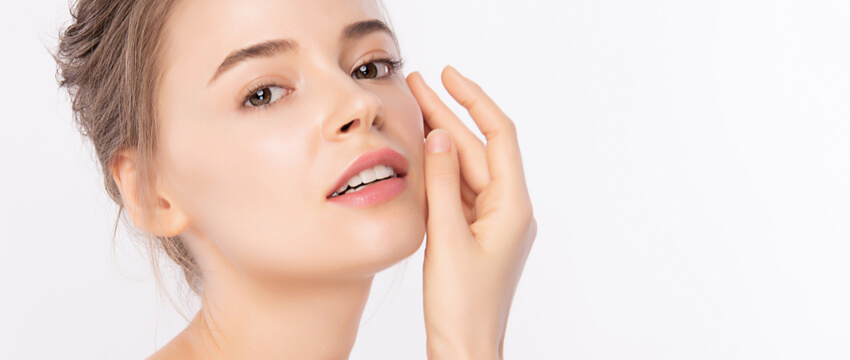Dermal fillers are minimally invasive and offer almost-instant results, however it’s essential that you follow your cosmetic surgeon’s dermal filler aftercare instructions to minimise any side effects and complications. While we will share some general tips and guidelines with you, you must still follow any post treatment instructions given by your aesthetician or cosmetic surgeon as closely as possible. Today we will take a look at the most important aspects of dermal filler aftercare.
What Are Dermal Fillers?
Dermal fillers are made from a gel-like substance that is injected under the surface of the skin.
Fillers can be used to
- Treat the signs of premature ageing such as creases, wrinkles and fine lines
- Add volume to areas of the face where volume has been lost, such as below the eyes, into the cheeks or the lips
- Add definition to parts of the face such as the jaw line and temples
- Add volume to the skin texture and plump up depressed areas such as those left behind by acne scarring
Minimising Side Effects And Complications
Fillers are a prescription-only treatment. It is possible for side effects and complications to occur, even when you work with a registered and experienced professional. The chances of side effects and complications are much greater if you have filler treatment in an unregistered facility. Knowing what to expect and how to care for side effects can make your recovery much more comfortable.
Dermal Filler Aftercare Best Practices
Follow these dermal filler aftercare instructions for faster healing and to minimise side effects:
- Stay away from extreme temperatures
- Keep your skin clean, by following your surgeon’s dermal filler aftercare instructions
- Do not rub or touch the areas that were injected
- Report any unusual side effects to your practitioner as soon as possible
- Avoid exercise for the first 24-hours after your treatment
Essential Dermal Filler Aftercare At Home
By following these dermal filler aftercare tips, you can recover from your treatment much faster and with less downtime
Use ice after your treatment
It is quite common for some swelling to occur after having dermal fillers. Some parts of the face may swell more than others, but you can manage this by using a cold compress on a regular basis.
Massage your skin if instructed to
In some cases, you will be advised to massage your skin after dermal fillers. In other instances, you will be instructed not to. You must follow your dermal filler aftercare instructions, as provided by your cosmetic expert.
Manage bruising
If you are someone who is prone to bruising, it is advisable to sleep with your head propped up on an extra pillow or two. It is also a good idea to sleep on your back after you have had fillers. Using an ice pack or cold compress may also help to minimise bruising.
Avoid exercise and extreme heat
After you have had dermal fillers, you need to keep the area calm and cool, so avoid extreme temperatures such as saunas and steam rooms and stay out of the direct sunlight.
Avoid alcohol
Alcohol causes blood vessel dilation, and this can contribute to bruising. You should definitely avoid alcohol for a few days after your dermal filler injections.
Avoid international flights for the first seven days
Flying in a pressurised cabin is not recommended after having fillers, so if you are planning to travel, make sure you leave yourself with enough time to recover from your departure.
Don’t forget about your review appointment


Your practitioner will check any residual swelling and how well the filler has settled since your treatment to make sure you are happy with the results.
Be patient
Depending on the amount of filler you would like, it could take more than one session to achieve your desired result. If you would like to have dermal fillers ahead of an important event, it is a good idea to make the appointment at least two weeks before the date, so you have enough time for any swelling to subside.
Know the warning signs
Part of your aftercare responsibility is knowing the warning signs of when something goes wrong. It’s up to you to report any warning signs of an infection or allergic reaction to your practitioner as soon as possible.
How Long Do Dermal Fillers Last?
The length of time that your fillers last will depend on the type of filler used, the amount of filler used, and where it was injected. It will also depend on how quickly your body reabsorbs the filler. On average most fillers last for between 6 and 24 months. Ask your practitioner what you can expect, and how often you may need to have them redone once you are satisfied with the outcome of your treatment.
For personalised dermal filler aftercare instructions or to find out more about the procedure, please contact us for a professional opinion: (02) 8599 7161.
References
Things To Consider Before Undergoing Cosmetic Procedures Like Dermal Fillers
https://www.tga.gov.au/community-qa/things-consider-undergoing-procedures-involving-dermal-fillers
Cosmetic Treatments: Injectables
https://www.betterhealth.vic.gov.au/health/conditionsandtreatments/cosmetic-treatments-injectables





